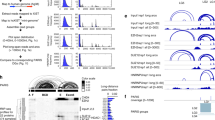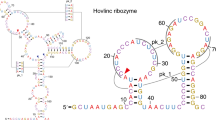Abstract
Long noncoding RNAs (lncRNAs) are important for gene expression, but little is known about their structures. RepA is a 1.6-kb mouse lncRNA comprising the same sequence as the 5′ region of Xist, including A and F repeats. It has been proposed to facilitate the initiation and spread of X-chromosome inactivation, although its exact role is poorly understood. To gain insight into the molecular mechanism of RepA and Xist, we determined a complete phylogenetically validated secondary-structural map of RepA through SHAPE and DMS chemical probing of a homogeneously folded RNA in vitro. We combined UV-cross-linking experiments with RNA modeling methods to produce a three-dimensional model of RepA functional domains demonstrating that tertiary architecture exists within lncRNA molecules and occurs within specific functional modules. This work provides a foundation for understanding of the evolution and functional properties of RepA and Xist and offers a framework for exploring architectural features of other lncRNAs.
This is a preview of subscription content, access via your institution
Access options
Access Nature and 54 other Nature Portfolio journals
Get Nature+, our best-value online-access subscription
$29.99 / 30 days
cancel any time
Subscribe to this journal
Receive 12 print issues and online access
$259.00 per year
only $21.58 per issue
Buy this article
- Purchase on Springer Link
- Instant access to full article PDF
Prices may be subject to local taxes which are calculated during checkout





Similar content being viewed by others
Accession codes
References
Flicek, P. et al. Ensembl 2014. Nucleic Acids Res. 42, D749–D755 (2014).
Wapinski, O. & Chang, H.Y. Long noncoding RNAs and human disease. Trends Cell Biol. 21, 354–361 (2011).
Gutschner, T. & Diederichs, S. The hallmarks of cancer: a long non-coding RNA point of view. RNA Biol. 9, 703–719 (2012).
Lee, J.T. Epigenetic regulation by long noncoding RNAs. Science 338, 1435–1439 (2012).
Sauvageau, M. et al. Multiple knockout mouse models reveal lincRNAs are required for life and brain development. eLife 2, e01749 (2013).
Yang, L., Froberg, J.E. & Lee, J.T. Long noncoding RNAs: fresh perspectives into the RNA world. Trends Biochem. Sci. 39, 35–43 (2014).
Quinn, J.J. & Chang, H.Y. Unique features of long non-coding RNA biogenesis and function. Nat. Rev. Genet. 17, 47–62 (2016).
Wan, Y. et al. Genome-wide measurement of RNA folding energies. Mol. Cell 48, 169–181 (2012).
Clark, M.B. et al. Genome-wide analysis of long noncoding RNA stability. Genome Res. 22, 885–898 (2012).
Ding, Y. et al. In vivo genome-wide profiling of RNA secondary structure reveals novel regulatory features. Nature 505, 696–700 (2014).
Novikova, I.V., Hennelly, S.P. & Sanbonmatsu, K.Y. Structural architecture of the human long non-coding RNA, steroid receptor RNA activator. Nucleic Acids Res. 40, 5034–5051 (2012).
Somarowthu, S. et al. HOTAIR forms an intricate and modular secondary structure. Mol. Cell 58, 353–361 (2015).
Brown, C.J. et al. The human XIST gene: analysis of a 17 kb inactive X-specific RNA that contains conserved repeats and is highly localized within the nucleus. Cell 71, 527–542 (1992).
Brockdorff, N. et al. The product of the mouse Xist gene is a 15 kb inactive X-specific transcript containing no conserved ORF and located in the nucleus. Cell 71, 515–526 (1992).
Lyon, M.F. Gene action in the X-chromosome of the mouse (Mus musculus L.). Nature 190, 372–373 (1961).
Galupa, R. & Heard, E. X-chromosome inactivation: new insights into cis and trans regulation. Curr. Opin. Genet. Dev. 31, 57–66 (2015).
Nesterova, T.B. et al. Characterization of the genomic Xist locus in rodents reveals conservation of overall gene structure and tandem repeats but rapid evolution of unique sequence. Genome Res. 11, 833–849 (2001).
Wutz, A., Rasmussen, T.P. & Jaenisch, R. Chromosomal silencing and localization are mediated by different domains of Xist RNA. Nat. Genet. 30, 167–174 (2002).
Zhao, J., Sun, B.K., Erwin, J.A., Song, J.J. & Lee, J.T. Polycomb proteins targeted by a short repeat RNA to the mouse X chromosome. Science 322, 750–756 (2008).
Sarma, K. et al. ATRX directs binding of PRC2 to Xist RNA and Polycomb targets. Cell 159, 869–883 (2014).
Chu, C. et al. Systematic discovery of Xist RNA binding proteins. Cell 161, 404–416 (2015).
McHugh, C.A. et al. The Xist lncRNA interacts directly with SHARP to silence transcription through HDAC3. Nature 521, 232–236 (2015).
Moindrot, B. et al. A pooled shRNA screen identifies Rbm15, Spen, and Wtap as factors required for Xist RNA-mediated silencing. Cell Rep. 12, 562–572 (2015).
Monfort, A. et al. Identification of Spen as a crucial factor for Xist function through forward genetic screening in haploid embryonic stem cells. Cell Rep. 12, 554–561 (2015).
Chen, C.K. et al. Xist recruits the X chromosome to the nuclear lamina to enable chromosome-wide silencing. Science 354, 468–472 (2016).
Duszczyk, M.M., Zanier, K. & Sattler, M. A NMR strategy to unambiguously distinguish nucleic acid hairpin and duplex conformations applied to a Xist RNA A-repeat. Nucleic Acids Res. 36, 7068–7077 (2008).
Maenner, S. et al. 2-D structure of the A region of Xist RNA and its implication for PRC2 association. PLoS Biol. 8, e1000276 (2010).
Duszczyk, M.M., Wutz, A., Rybin, V. & Sattler, M. The Xist RNA A-repeat comprises a novel AUCG tetraloop fold and a platform for multimerization. RNA 17, 1973–1982 (2011).
Fang, R., Moss, W.N., Rutenberg-Schoenberg, M. & Simon, M.D. Probing Xist RNA structure in cells using Targeted Structure-Seq. PLoS Genet. 11, e1005668 (2015).
Lu, Z. et al. RNA duplex map in living cells reveals higher-order transcriptome structure. Cell 165, 1267–1279 (2016).
Ramachandran, S., Ding, F., Weeks, K.M. & Dokholyan, N.V. Statistical analysis of SHAPE-directed RNA secondary structure modeling. Biochemistry 52, 596–599 (2013).
Mathews, D.H. Using an RNA secondary structure partition function to determine confidence in base pairs predicted by free energy minimization. RNA 10, 1178–1190 (2004).
Takamoto, K. et al. Principles of RNA compaction: insights from the equilibrium folding pathway of the P4-P6 RNA domain in monovalent cations. J. Mol. Biol. 343, 1195–1206 (2004).
Pyle, A.M., Fedorova, O. & Waldsich, C. Folding of group II introns: a model system for large, multidomain RNAs? Trends Biochem. Sci. 32, 138–145 (2007).
Fernández-Luna, M.T. & Miranda-Ríos, J. Riboswitch folding: one at a time and step by step. RNA Biol. 5, 20–23 (2008).
Su, L.J., Brenowitz, M. & Pyle, A.M. An alternative route for the folding of large RNAs: apparent two-state folding by a group II intron ribozyme. J. Mol. Biol. 334, 639–652 (2003).
Novikova, I.V., Dharap, A., Hennelly, S.P. & Sanbonmatsu, K.Y. 3S: shotgun secondary structure determination of long non-coding RNAs. Methods 63, 170–177 (2013).
Kent, W.J. et al. The human genome browser at UCSC. Genome Res. 12, 996–1006 (2002).
Nawrocki, E.P. & Eddy, S.R. Infernal 1.1: 100-fold faster RNA homology searches. Bioinformatics 29, 2933–2935 (2013).
Harris, M.E. & Christian, E.L. RNA crosslinking methods. Methods Enzymol. 468, 127–146 (2009).
Popenda, M. et al. Automated 3D structure composition for large RNAs. Nucleic Acids Res. 40, e112 (2012).
da Rocha, S.T. et al. Jarid2 is implicated in the initial Xist-induced targeting of PRC2 to the inactive X chromosome. Mol. Cell 53, 301–316 (2014).
Schuck, P. Size-distribution analysis of macromolecules by sedimentation velocity ultracentrifugation and lamm equation modeling. Biophys. J. 78, 1606–1619 (2000).
Brown, P.H. & Schuck, P. Macromolecular size-and-shape distributions by sedimentation velocity analytical ultracentrifugation. Biophys. J. 90, 4651–4661 (2006).
Mortimer, S.A. & Weeks, K.M. A fast-acting reagent for accurate analysis of RNA secondary and tertiary structure by SHAPE chemistry. J. Am. Chem. Soc. 129, 4144–4145 (2007).
Vasa, S.M., Guex, N., Wilkinson, K.A., Weeks, K.M. & Giddings, M.C. ShapeFinder: a software system for high-throughput quantitative analysis of nucleic acid reactivity information resolved by capillary electrophoresis. RNA 14, 1979–1990 (2008).
McGinnis, J.L., Duncan, C.D. & Weeks, K.M. High-throughput SHAPE and hydroxyl radical analysis of RNA structure and ribonucleoprotein assembly. Methods Enzymol. 468, 67–89 (2009).
Rouskin, S., Zubradt, M., Washietl, S., Kellis, M. & Weissman, J.S. Genome-wide probing of RNA structure reveals active unfolding of mRNA structures in vivo. Nature 505, 701–705 (2014).
Low, J.T. & Weeks, K.M. SHAPE-directed RNA secondary structure prediction. Methods 52, 150–158 (2010).
Weinberg, Z. & Breaker, R.R. R2R: software to speed the depiction of aesthetic consensus RNA secondary structures. BMC Bioinformatics 12, 3 (2011).
Acknowledgements
We acknowledge M. Simon (Yale University) for sharing the in vivo DMS probing data of Xist and E. Jagdmann for the synthesis of 1M7. We thank T. Dickey, C. Zhao, O. Fedorova, and all other members of the Pyle laboratory for constructive discussion and critical reading of the manuscript. This project was supported by the National Institutes of Health (R01GM50313). A.M.P. is supported as an Investigator, and F.L. is supported as a Postdoctoral Fellow, of the Howard Hughes Medical Institute.
Author information
Authors and Affiliations
Contributions
F.L. and A.M.P. designed the project. F.L. performed the SV-AUC, SEC, SHAPE and DMS probing, and UV-cross-linking experiments and analyzed the data obtained from the aforementioned experiments; F.L. performed the phylogenetic studies; S.S. conducted jackknife resampling, Shannon entropy, and bootstrapping analyses, and performed 3D modeling experiments. F.L., S.S., and A.M.P. wrote the manuscript.
Corresponding author
Ethics declarations
Competing interests
The authors declare no competing financial interests.
Supplementary information
Supplementary Text and Figures
Supplementary Results, Supplementary Figures 1–11 and Supplementary Table 1 (PDF 20667 kb)
Rights and permissions
About this article
Cite this article
Liu, F., Somarowthu, S. & Pyle, A. Visualizing the secondary and tertiary architectural domains of lncRNA RepA. Nat Chem Biol 13, 282–289 (2017). https://doi.org/10.1038/nchembio.2272
Received:
Accepted:
Published:
Issue Date:
DOI: https://doi.org/10.1038/nchembio.2272
This article is cited by
-
Towards higher-resolution and in vivo understanding of lncRNA biogenesis and function
Nature Methods (2022)
-
Targeting Xist with compounds that disrupt RNA structure and X inactivation
Nature (2022)
-
Enhancer RNAs stimulate Pol II pause release by harnessing multivalent interactions to NELF
Nature Communications (2022)
-
Getting to the bottom of lncRNA mechanism: structure–function relationships
Mammalian Genome (2022)
-
RNA structure probing uncovers RNA structure-dependent biological functions
Nature Chemical Biology (2021)



